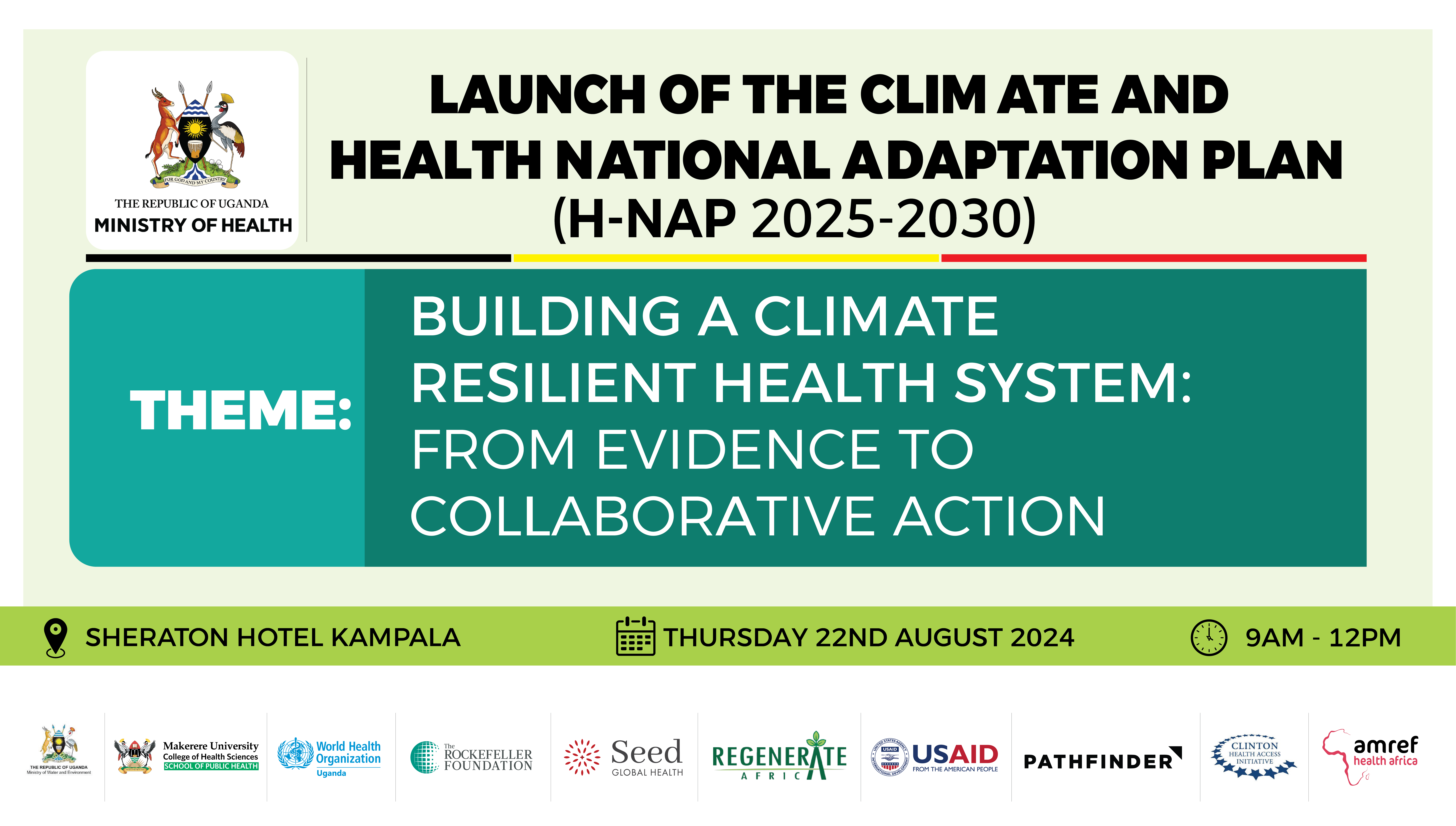
Event Date/s
Event Details
The Ministry of Health-Uganda will launch the Climate and Health National Adaptation Plan (H-NAP) 2025-2030 on Thursday, August 22nd, 2024, at Sheraton Hotel, Kampala.
The development process for this document was led by the Ministry of Health, Makerere University School of Public Health (MakSPH), supported by the Rockefeller Foundation and WHO.
This launch aims to strengthen Uganda's health system against climate change, ensuring sustainable healthcare services during climatic challenges. It will also serve as a platform for climate and health experts to discuss and mobilize resources for H-NAP’s nationwide implementation.
The H-NAP
Climate change is a major health threat, affecting Uganda through floods, droughts, and temperature changes. The Ministry of Health, guided by the Vulnerability & Adaptation Assessment (VAA), has developed the H-NAP to build a climate-resilient health system. This plan calls for collaboration across sectors to address climate challenges.
COP26: Uganda committed to conduct a health VAA and develop an H-NAP, integrated into the broader NAP.
VAA Execution: In Sep 2023, MaKSPH, MoH, WHO, and Rockefeller Foundation conducted the VAA.
Vision: A responsive, adaptive, and resilient health system that protects and promotes the health and well-being of the people of Uganda.
Mission: Establish a responsive health system that promotes inclusive Climate Change Adaptation measures.
Goal: To strengthen the adaptive capacity of the health system to climate change and related hazards.
______________________________
Building a Climate Resilient Health System in Uganda
The H-NAP aims to enhance Uganda's health system resilience against climate change by incorporating climate adaptation into health strategies and planning, ensuring sustainable and continuous healthcare services during climatic challenges
______________________________
About the VAA
The H-NAP follows a Vulnerability and Adaptability Assessment (VAA) that was conducted in 716 Health Facilities in Uganda by Makerere University School of Public Health (MakSPH) following the WHO-recommended approach with funding from The Rockefeller Foundation which noted a significant exposure of healthcare facilities in Uganda to various climate-related hazards.
The results from the VAA show that nearly half (48%) of the healthcare facilities face drought, 40% are exposed to floods, 31.1% to storms, 12% to rising water levels, 12% to landslides, 9% to lightning, 2.0% to heat waves, and 0.1% to cold waves. Regional referral hospitals have the least exposure compared to lower-level facilities, which are more vulnerable to storms, high water levels, floods, drought, and landslides.
The assessment also highlighted several vulnerabilities regarding the health workforce, water management and the healthcare infrastructure. For instance, many healthcare workers do not participate in drought adaptation planning (58.1%). There is a lack of sun protection and hydration supplies for outdoor work (60.4% for drought, 78.6% for heat waves), training on health conditions worsened by drought (56.0%), and provisions for drinking water during droughts (49.3%) and heat waves (50.0%), and training on health conditions worsened by drought (56.0%). Nearly half lack drinking water provisions during droughts (49.3%) and heat waves (50.0%). Over 58.9% lack plans to schedule outdoor work during cooler times to mitigate heat risks.
Also, a significant proportion of facilities lack water safety and management plans to address contamination risks. About 55.1% of facilities exposed to drought and 58.7% exposed to floods lack water safety plans, contingency plans for monitoring and reducing contaminants, and onsite water purification equipment. Additionally, 61% of facilities do not have long-term drought management or emergency water supply plans (59.7% for floods, 66.7% for landslides), highlighting a critical gap in ensuring safe water access during and after hazards.
As for infrastructure, many health facilities in Uganda lack adequate infrastructure to cope with climate hazards, such as stormwater management systems (75.6% for storms) and natural floodwater infiltration systems (68.6% for floods).
| Attachment | Size |
|---|---|
| climate_h-nap_summary (1.47 MB) | 1.47 MB |

